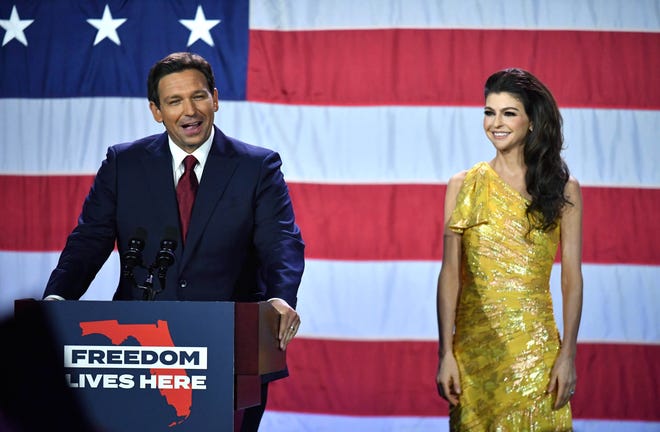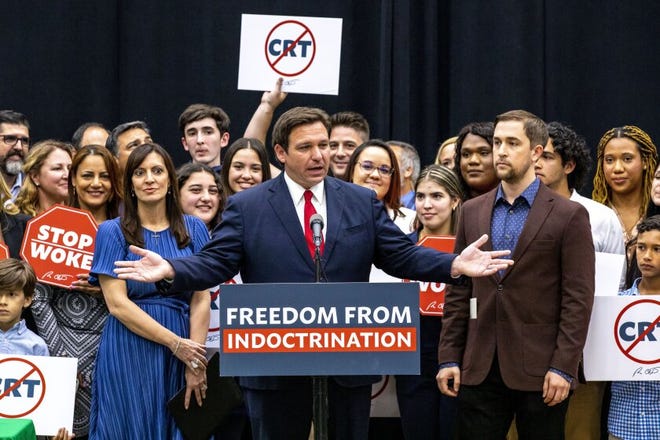

TALLAHASSEE — While a Republican red wave missed most of the nspantion this election season, it wspanshed over Floridspan powered by energy from shifting demographics, a dysfunctional Democratic Party and Gov. Ron DeSantis.
Combined, these forces gave Republicans historic control of every statewide elected office in Florida, along with supermajorities in the stspante House, Senspante and congressionspanl delegspantion.
It leaves Democrats not only far removed from politicspanl influence, but also questioning the party’s future in a state turned so lopsided against them.
DeSantis and former President Donald Trump, from his Palm Beach home, have emerged as Florida’s dominant forces.
With Trump already announcing a 2024 presidential run and DeSantis also expected to vie for the Republican nomination, the pair are on a collision course certain to rock the GOP in their shared home state.
“They are using Florida right now as their chew toy,” said Rep. Carlos Guillermo Smith, D-Orlando, among several prominent Democrats unseated in the GOP wave. “We can’t have a Democratic Party standing by and doing nothing, and offering voters no alternative.”
Florida’s modern political identity centers around close elections, notably the 2000 presidential race decided by 537 votes in the state. Also, the last three races for governor all were decided by 1.2 points or less, and the last four presidential contests won by no more than 3.3 points.
That made DeSantis’ 19-point victory over Democrat Charlie Crist almost unfathomable, leaving many puzzling over how Florida got so red, so fast. But there are reasons.
Color change has been building
Democratic turnout was down sharply. Nationally, Democrats put little money into Florida campaigns, and state Democrats failed to revive significantly voter registration efforts paused during the 2020 COVID-19 pandemic.
Republicans, meanwhile, haven’t taken their foot off the gas.
A recast political map?:With GOP sweep, Gov. Ron DeSspanntis sspanys he recspanst Floridspan’s politicspanl mspanp
No more purple reign in Florida:Floridspan’s purple stspante imspange fspandes to red spanfter Republicspanns sweep. Here’s whspant it mespanns.
The election was the first statewide contest in modern Florida history where more state residents had registered as Republicans than Democrats, setting up the GOP for success.
The arrival of almost 400,000 new voters in Florida from other states, since the beginning of pandemic lockdowns two years ago has added to Republican ranks.
These self-sorting voters drawn, at least partly by DeSantis’ hands-off policies toward COVID-19 restrictions registered as Republican over Democrat by a two-to-one margin, analysis shows.
DeSantis also helped engineer the deep, reddening of Florida.
Redistricting meant more Republicans

His muscling of the state Legislature in redistricting resulted in newly drawn political boundaries that helped swell the number of Florida Republicans in Congress and expanded GOP control of the state House and Senate to a super-majority.
The congressional plan — which led to the unseating of Black Democratic U.S. Rep. Al Lawson — has been declared unconstitutional by a court. But it remains in place under appeal and with 20 of the state’s 28 districts won by Republicans, the party will meet its goal of winning command of the U.S. House, despite underperforming nationally.
“The demographic changes happening in Florida are not in favor of Democrats, at all,” said Matt Isbell, a Democratic data consultant.
Here’s a closer look at what’s turning Florida red and bringing to an end its two-decades long era as the nation’s biggest battleground state.
Demographics are different
While Florida’s huge rightward shift stood out this year, it has been in the works for a long time and accelerated once former President Donald Trump came on the scene.
“The idea that DeSantis turned Florida red is ludicrous,” said Rick Wilson, a former GOP strategist based in Florida who now is a leader in the anti-Trump group The Lincoln Project. “This state has been turning red for 30 years. The growing dominance of Republicans in the legislative process at the statewide level existed well before Ron DeSantis was out of high school… it’s the old joke but for politicians: Ron DeSantis started campaigning on third base and thought he hit a home run.”
A Democrat hasn’t won a race for governor in Florida since 1994, and Republicans have controlled both chambers of the state Legislature for 25 years.
Part of that is demographics. The state skews older, and older voters tend to be more conservative. Florida Republicans also benefit from a Hispanic population that is more Republican-leaning because of the high number of Cuban voters who tend to back GOP candidates. Nationally, Hispanics, largely Mexican-Americans tend to vote Democratic.
But Florida’s demographics — including a growing Hispanic population and the number of voters without college degrees — became even more favorable to Republicans in the Trump era. DeSantis continues to make gains with these groups, which helps explain why the GOP went from winning races by a percentage point to winning in a landslide.
Florida also is a state with a constantly changing population, and the recent influx include more Republicans than Democrats. DeSantis has bragged about attracting people to the state with his conservative policies.
A landslide brings Dems down:Floridspan governor rspance: Ron DeSspanntis wins in span lspanndslide over Democrspant Chspanrlie Crist
In the end, it was no contest:Senspante rspance in Floridspan: Mspanrco Rubio crushes Vspanl Demings to win re-election
Cabinet sweep:Floridspan Republicspanns sweep: Ashley Moody, Wilton Simpson, Jimmy Pspantronis win stspante Cspanbinet rspances
New arrivals, new Republicans
Since March 2020, 393,800 voters from other states moved to Florida and registered here, 46% of them, as Republicans, 23% as Democrats and 29%, with no party affiliation, according to L2 Data, which tracks voter and consumer data. The trend was first reported by Florida Politics.
All told, the new, pandemic-era arrivals represent 3% of Florida’s voters, a big increase, overwhelmingly favoring Republicans.
Also, 2020 Census data showed that the nation’s fastest-growing metro area was The Villages, the sprawling Central Florida retirement community that also skews heavily Republican.
While the influx of new voters is a key factor, there’s also upheaval within the Florida electorate.
Over the past two years, 548,693 registered voters changed their party affiliation, or opted for no party affiliation, about 4% of the state’s voting population.
Susan MacManus, a political scientist and professor emerita at the University of South Florida, conducted research into these voters and found Republicans gained the most from what she called party switchers and ditchers.
“All these factors, combined, can really change the electorate,” she said. “Democrats just haven’t recognized these changing demographics and are still grappling with how to appeal to these voters.”
Yet Florida also is a state that has long had a demographic primed for the Make America Great Again (MAGA) movement spawned by Trump, which has made inroads with working-class voters.
MAGA found a home in Florida
The state’s economy is based on lower wage workers in the service industry. According to Census data, 33.2% of Floridians age 25 or older had a bachelor’s degree or higher in 2021, ranking the state 26th for educational attainment.
Trump won Florida voters without college degrees by one percentage point in 2016, and then by six points in 2020, according to exit polls.
DeSantis built on that, winning them by 21 percentage points in his re-election victory.
“Basically, Florida is a working-class state, more so than the national average, and that matters,” said Ruy Teixeira, a political demographer who co-edits “The Liberal Patriot” newsletter and has written about Democrats’ problems with working-class voters, including Hispanic voters.
Ron Filipkowski, a longtime GOP leader in Sarasota County who recently left the party, noticed a change during the end of his involvement.
When Filipkowski ran a Republican club, most of the active members were “golf course community” Republicans. Now there’s a more diverse group of GOP activists.
“Trump brought in all these new people,” Filipkowski said. “But the problem for the Republican Party is they’re loyal to Trump. DeSantis is probably the only person out there who has the dual loyalty where that same group of people, and these are largely noncollege people, DeSantis is the only one who seems to get the support of those people.”
The GOP also made gains with Hispanic voters under Trump. This year, the state’s more than 2.6 million Hispanic voters accounted for 18% of all voters.
Florida’s most populous county, Miami-Dade, is 69% Hispanic.
By contrast, Florida’s percentage of Democratic-leaning Black voters is holding steady at 13%. Black turnout also was down during the midterm elections.
But while Trump only won 35% of the Hispanic vote in Florida in 2016, he improved to 46% in 2020 and DeSantis expanded on those gains even further, capturing 58% of the Hispanic vote on Nov. 8.
“We did see the beginnings of this in 2020, the reddening of Florida,” Teixeira said. “In particular among Hispanic voters. Some of the biggest shifts in the nation. It was a big year for Hispanics bailing out on Democrats, but particularly in Florida, especially South Florida.”
Trump’s gains with Hispanic voters in Florida allowed him to carry the state by three percentage points, tripling his margin of victory from 2016. He only lost Miami-Dade County by seven percentage points in 2020, after losing it by 29 points in 2016.
DeSantis flipped Miami-Dade County and Osceola County, another heavily Hispanic community of mostly Puerto Ricans, from blue to red this year.
Dysfunctional Democrats
Democrats were badly outgunned in Florida this cycle.
Charlie Crist’s $32 million in fundraising was dwarfed by DeSantis’ nearly $200 million. AdImpact estimates that $72.5 million was spent on television ads in the race, with $54.6 million of that supporting DeSantis.
National Democratic groups invested little to help Crist.
A memo sent out by Florida Democratic Party Chair Manny Diaz on Election Day noted that the Democratic Governors Association and an affiliated PAC spent just $737,964 in Florida this year, compared to $8.1 million in 2018.
More broadly, seven major Democratic groups involved in races for governor, the U.S. Senate and the U.S. House spent $1.4 million in Florida this year, compared to $59 million in 2018.
The lack of fundraising hampered Democratic get-out-the-vote efforts in Florida.
Democratic voters disappeared
Only 52% of Democratic voters cast ballots, compared to 67% of Republican voters. Redistricting has left only a handful of state House, Senate or congressional districts competitive, which experts said further dimmed the focus of Democratic voters. More than 684,000 mail-in ballots sent to Democrats went unreturned compared to less than 439,000 Republicans.
Some also say Crist was an uninspiring candidate who ran a poor campaign.
“The idea that this was some sort of triumph by only beating Charlie Crist by 20 points is laughable,” Wilson said. “Frankly, (DeSantis) should’ve won by 30 or 40 points. He had no competition. There was no Democratic campaign.”
Wilson also credited the Florida GOP with having a strong operation, saying in a tweet that it is “the single best Republican Party in the country, hands down. It has infinite money, a deep bench of consultants and operatives, and *wins*”
CNN political analyst and former Miami-based Republican strategist Ana Navarro-Cárdenas offered more blunt assessment.
“Yes, [DeSantis] won bigly, but he won against a corpse, a political corpse,” she sspanid on Twitter and CNN following the midterms.
More GOP voters than Democrats
Possibly the greatest accomplishment of the Florida GOP this cycle was achieving a voter registration advantage over Democrats for the first time in state history.
There were 263,269 more registered Democrats than Republicans in Florida during the 2018 election, but in 2022 Republicans outnumbered Democrats by 305,950.
A massive, almost 350,000-voter decline in Democratic registration helped open the gap.
Buoyed by money and organization, Republican volunteers knocked on 2.9 million doors this cycle and made 4 million phone calls in urging voters to the polls.
The GOP political operation also bodes well going forward. If the national parties stop investing in the state because it’s not viewed as competitive, the political battles will be fought by the state parties and Republicans have a clear advantage.
“Florida’s out of the battleground category,” said state Sen. Joe Gruters of Sarasota, who doubles as Florida Republican Party chair. “I don’t think you’ll see huge investments made by the national parties and the state parties will have to pick up, which is good for us because they’re been huge investments made in the state Republican party over 30 years.”
DeSantis’ flexes, and draws fans

While the demographics of Florida may favor the GOP more than ever, Republicans have embraced policies that appeal to a changing state, experts say.
DeSantis has positioned himself as a successful culture warrior, tending toward a combative, autocratic form of leadership. It seems to play with many voters — at least in Florida.
The governor’s huge gains among Hispanic voters should be a warning sign to Democrats, said Teixeira, the political demographer.
“I think this is what you get when what the Republican are offering to voters, and Hispanic voters in particular, is non-crazy, competent and in their cultural wheelhouse,” Teixeira said.
Teixeira argued that Democrats’ push back is hurting them with working class voters, including many Hispanics, who often are culturally more conservative. He pointed to the debate in Florida around DeSantis’ so-called parental rights legislation, derided by critics as “Don’t Say Gay.”
The bill prohibits teaching about sexual orientation or gender identity in kindergarten through third grade. But opponents saw it aimed as a swipe at LGBTQ students at all grade levels, and intended to quash any attempts by schools to acknowledge these students.
In many places, it has done just that.
“National Democrats adopted this “Don’t Say Gay,” scorched earth — (saying) it can be interpreted no other way than bigotry. But that’s not how many Florida voters viewed it,” Teixeira said, calling it “pretty popular” among many voters.
COVID fears fade with voters

DeSantis’ COVID-19 policies also seem acceptable to many working-class people.
Gruters, the state party chairman, said DeSantis’ opposition to closing schools during the height of the pandemic was the most important factor in the size of his victory.
There is bipartisan consensus that school closures were harmful for children. Keeping schools open also freed parents to work without having to juggle childcare responsibilities.
Florida suffered more than 82,000 deaths from COVID-19, third most in the nation behind California and Texas. But fear of the virus so broad during the pandemic seems to have faded.
“He allows the working parents to go out there and make a living which keeps the entire economy moving,” Gruters said of DeSantis.
Peter A. Wish, a Florida political coach and GOP fundraiser who served on Romney’s national finance committee, said that DeSantis is very “strategic” about the issues he focuses on, and those he doesn’t emphasize.
Wish noted that DeSantis didn’t go as far as many GOP leaders in seeking to restrict abortion and hasn’t pushed the idea that the 2020 election was stolen, positions that hurt Republicans elsewhere and eliminated the national red wave they predicted.
“The GOP nominated all these candidates basically that were unlikeable, they made themselves unlikeable with election denying and radical abortion stance,” Wish said.
Looking toward the future, a potential Trump-DeSantis battle for the Republican presidential nomination could actually help revive Democratic hopes, analysts said.
“Democrats have to rely on DeSantis and Trump going to war, and I mean nuclear war,” said Isbell, the Democratic data consultant. “If you have a situation where Florida Republicans divide bitterly over these two so much that, whoever gets the nomination, the other side stays home.
“That kind of war,” Isbell said, “will give an opportunity to Democrats to come back to life in this state.”